Automatic Scheduling Tool for Balloon-Borne Planetary Optical Remote Sensing
Abstract
1. Introduction
2. Algorithm Description
2.1. Observation Windows
2.2. Derived Information
2.2.1. Air Mass
2.2.2. Parallactic Angle
2.3. Coding
3. Results
3.1. Results for Virtual Ground-Based Observatory (VGO)
3.2. Results for Planetary Atmosphere Spectroscopic Telescope (PAST)
3.3. Results for Joint Observation
4. Conclusions and Future Work
Author Contributions
Funding
Data Availability Statement
Acknowledgments
Conflicts of Interest
Appendix A
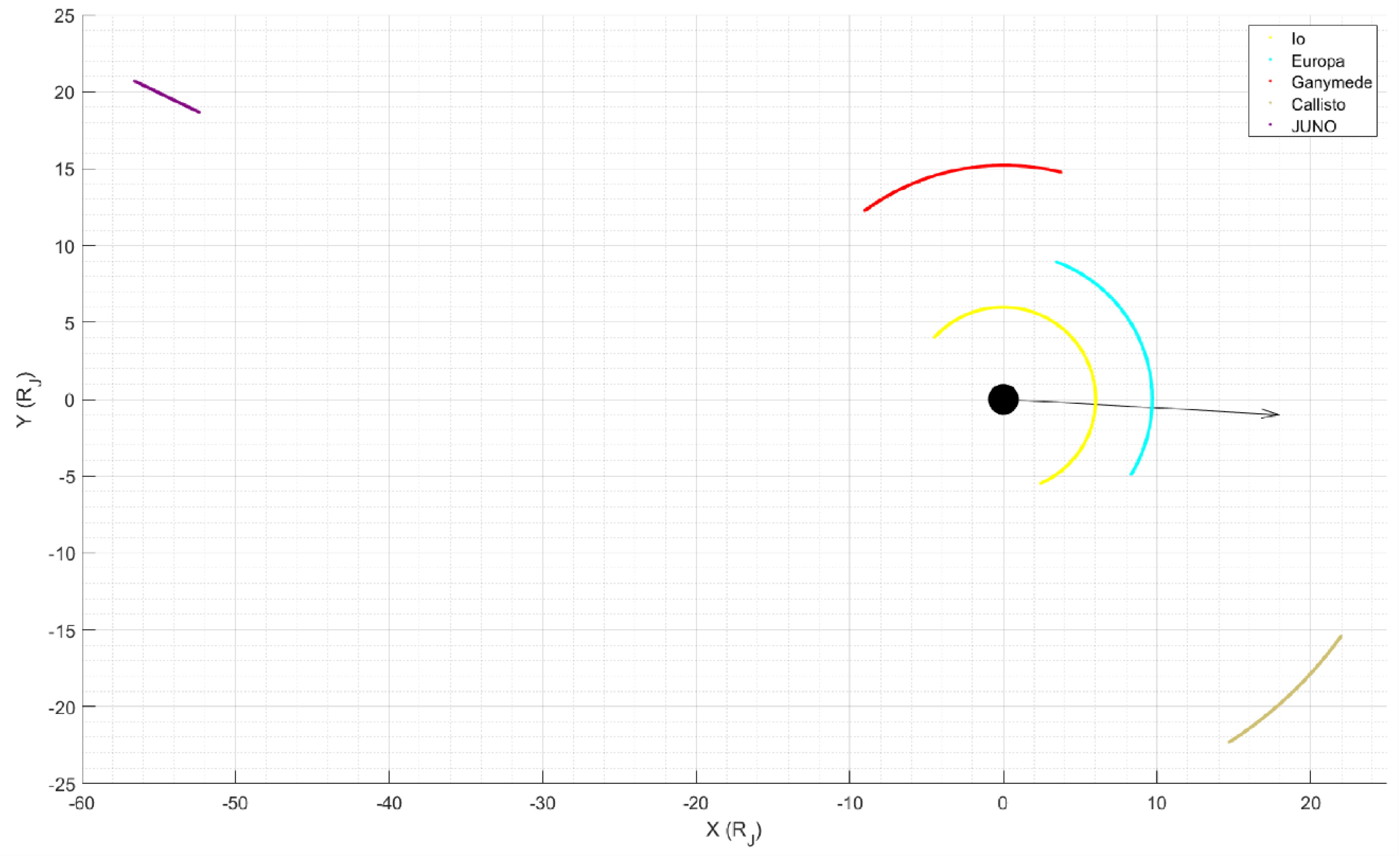
References
- He, F. Remote sensing of planetary space environment. Chin. Sci. Bull. 2020, 65, 1305–1319. [Google Scholar] [CrossRef]
- Yong, W. Construction of Planetary Science as a first-level scientific discipline: Exploration and practice of Scientific Experiment System in Near Space (SENSE) Program. Chin. Sci. Bull. 2020, 65, 1295–1296. [Google Scholar] [CrossRef]
- Picone, J.M.; Hedin, A.E.; Drob, D.P.; Aikin, A.C. NRLMSISE-00 empirical model of the atmosphere: Statistical comparisons and scientific issues. J. Geophys. Res. 2002, 107, 1468. [Google Scholar] [CrossRef]
- Mora, M.; Solar, M. A survey on the dynamic scheduling problem in astronomical observations. In Artificial Intelligence in Theory and Practice, 3rd ed.; Bramer, M., Ed.; Springer: Berlin, Germany, 2010; Volume 331, pp. 111–120. ISBN 1868-4238. [Google Scholar] [CrossRef]
- Johnston, M.D.; Miller, G.E. Spike: Intelligent scheduling of Hubble space telescope observations. In Intelligent Scheduling; Fox, M., Zweben, M., Eds.; Morgan Kaufmann Publishers: San Francisco, CA, USA, 1994; pp. 391–422. ISBN 1558602607. [Google Scholar]
- Pickering, K.A. The southern limit of the ancient star catalog and the commentary of Hipparchos. DIO Int. J. Sci. Hist. 2002, 12, 3–27. [Google Scholar]
- Young, A.T. Air mass and refraction. Appl. Opt. 1994, 33, 1108–1110. [Google Scholar] [CrossRef]
- Young, A.T.; Irvine, W.M. Multicolor Photoelectric Photometry of Brighter Planets. I. Program and Procedure. Astron. J. 1967, 72, 945. [Google Scholar] [CrossRef]
- Acton, C.H. Ancillary Data Services of NASA’s Navigation and Ancillary Information Facility. Planet. Space Sci. 1996, 44, 65–70. [Google Scholar] [CrossRef]
- Acton, C.; Bachman, N.; Semenov, B.; Wright, E. A look toward the future in the handling of space science mission geometry. Planet. Space Sci. 2017, 150, 9–12. [Google Scholar] [CrossRef]
- Folkner, W.M.; Williams, J.G.; Boggs, D.H.; Park, R.S.; Kuchynka, P. The Planetary and Lunar Ephemerides DE430 and DE431. IPN Progress Report. 2014; pp. 42–196. Available online: http://ipnpr.jpl.nasa.gov/progress_report/42-196/196C.pdf (accessed on 8 March 2021).
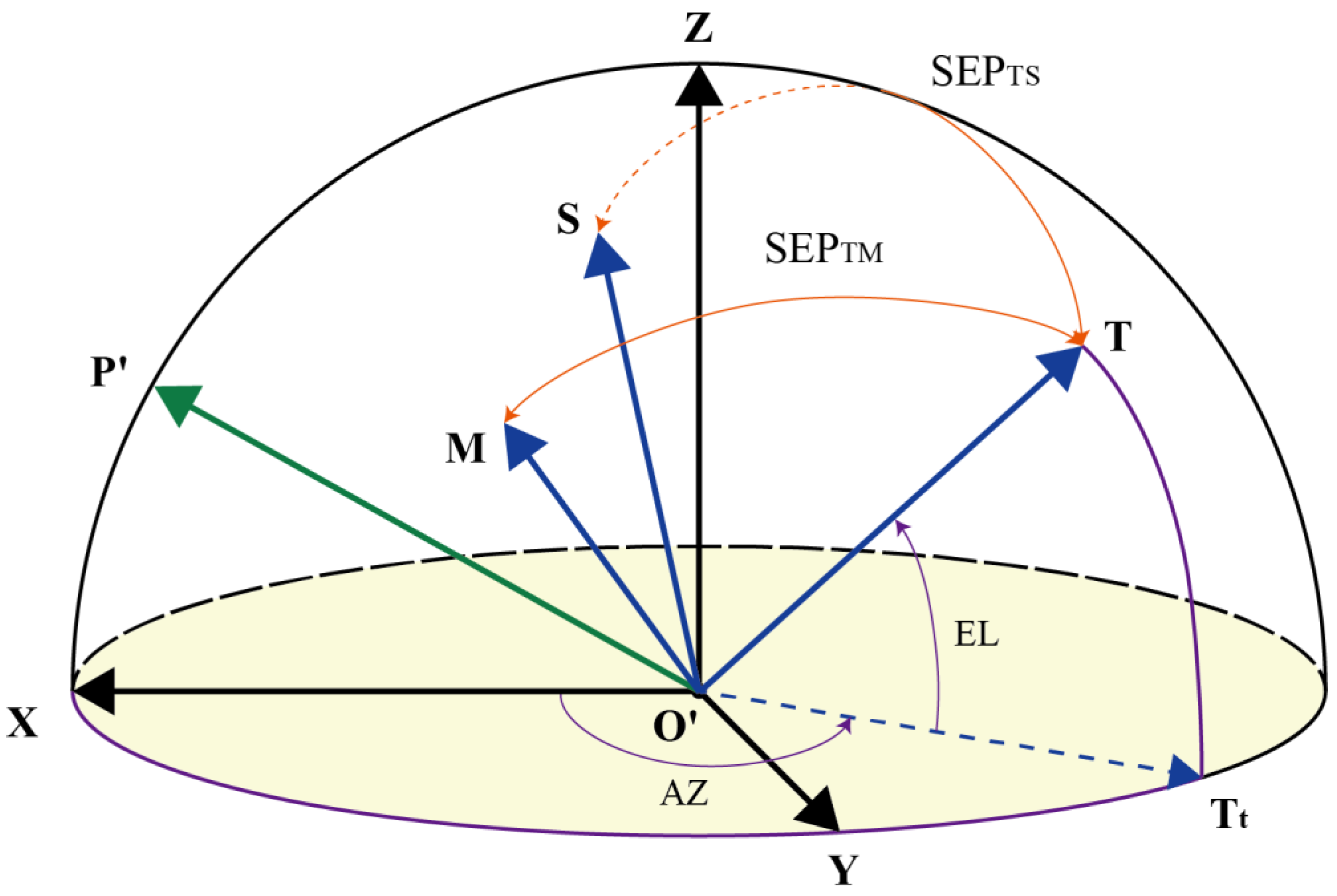
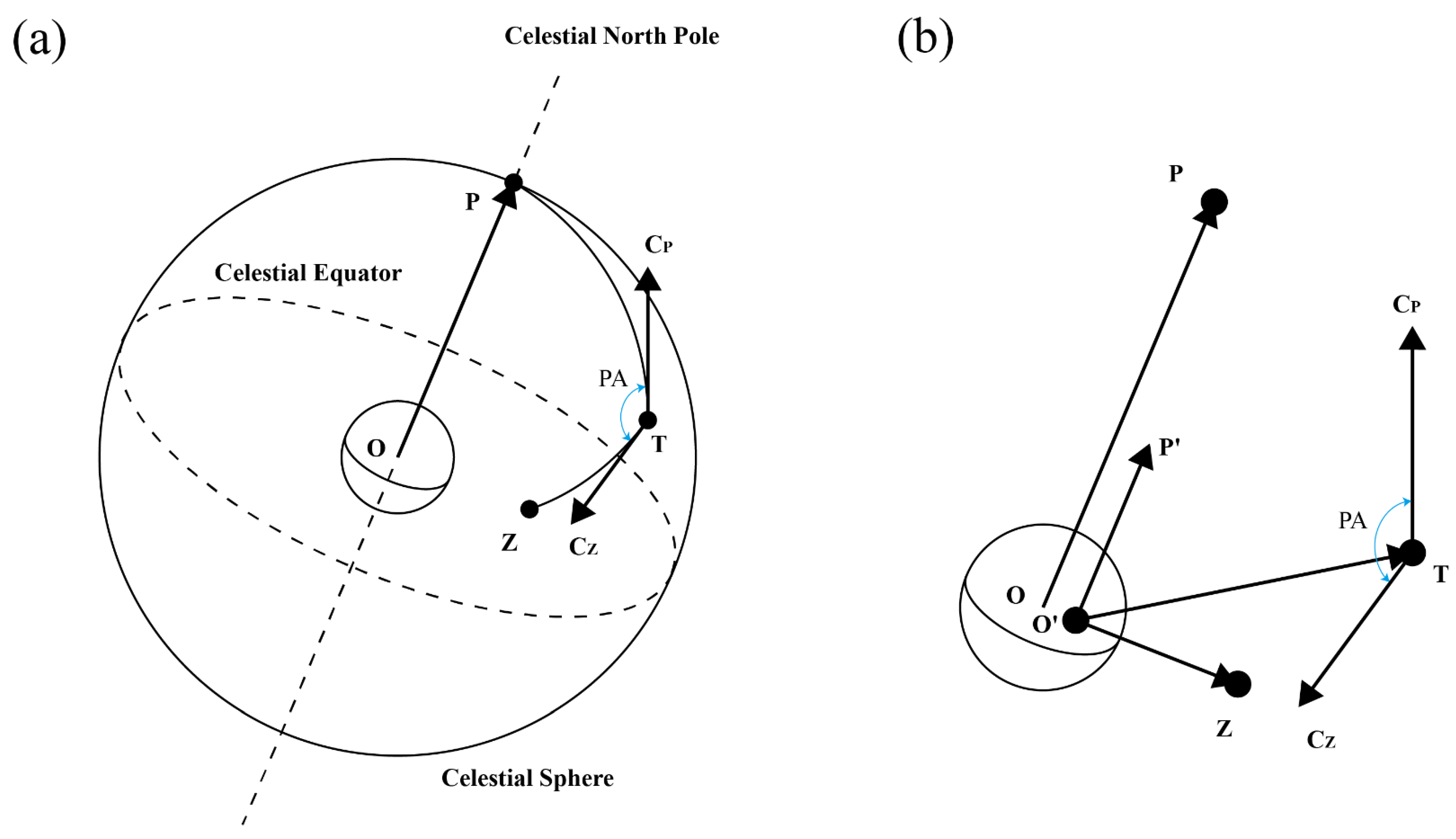


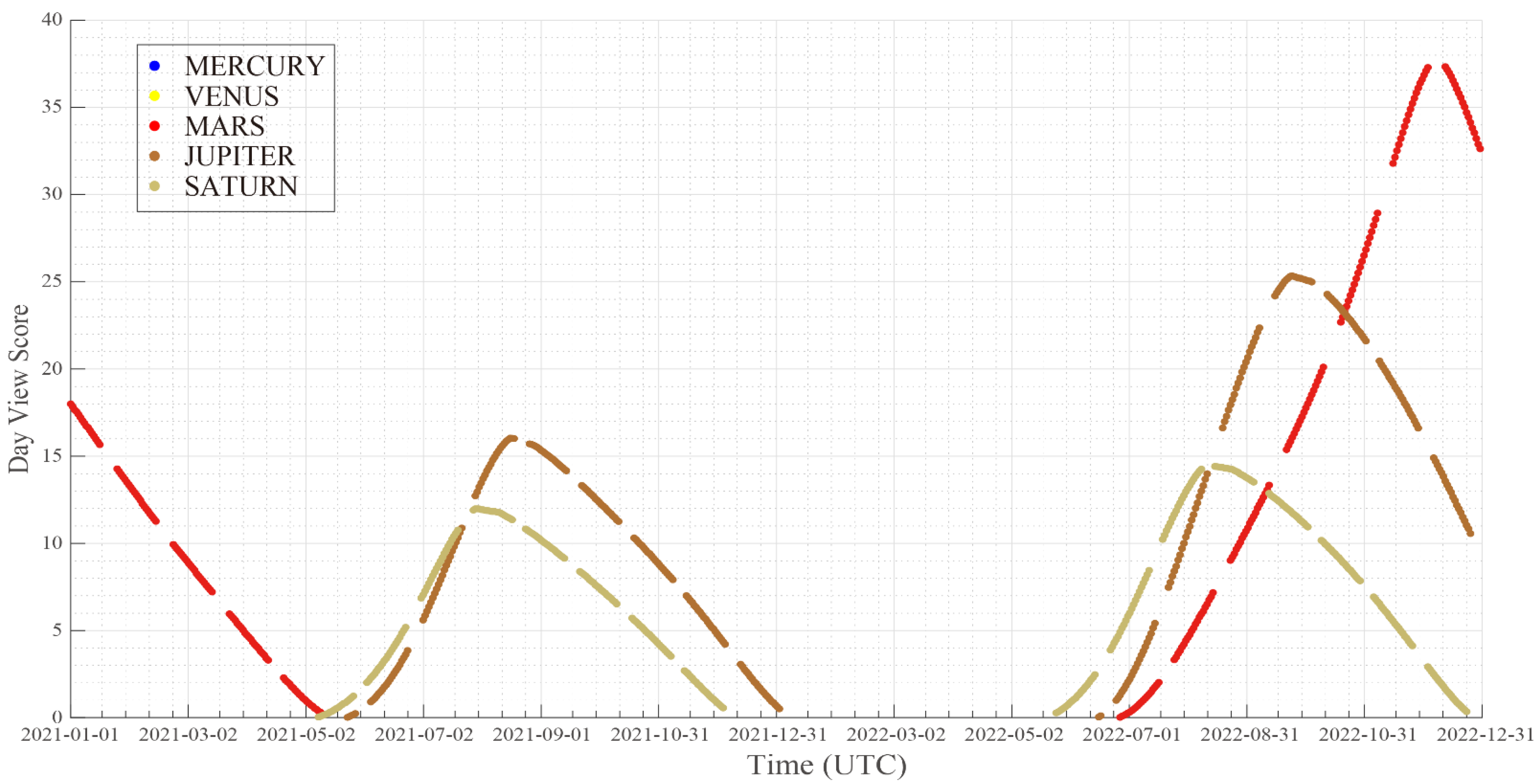

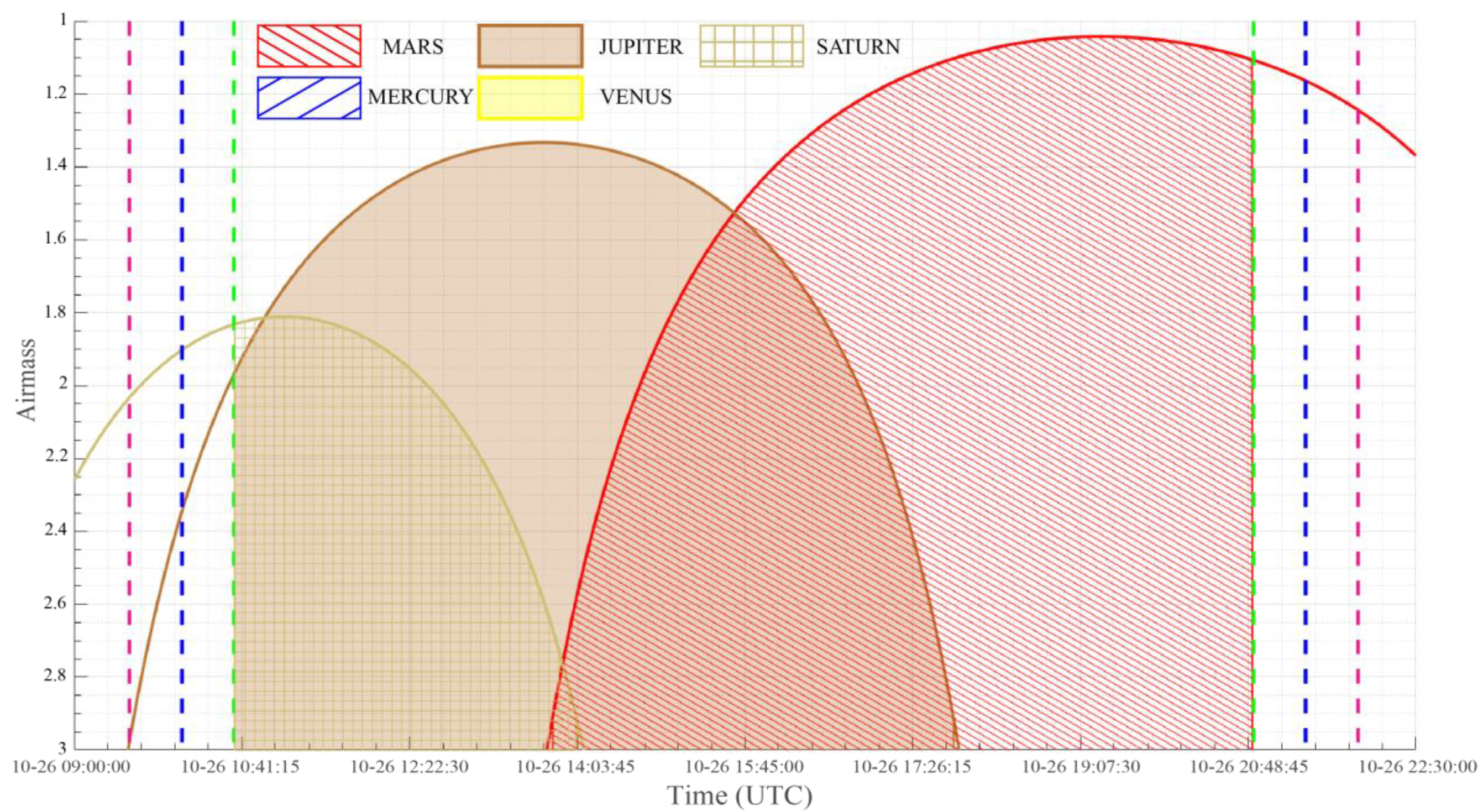

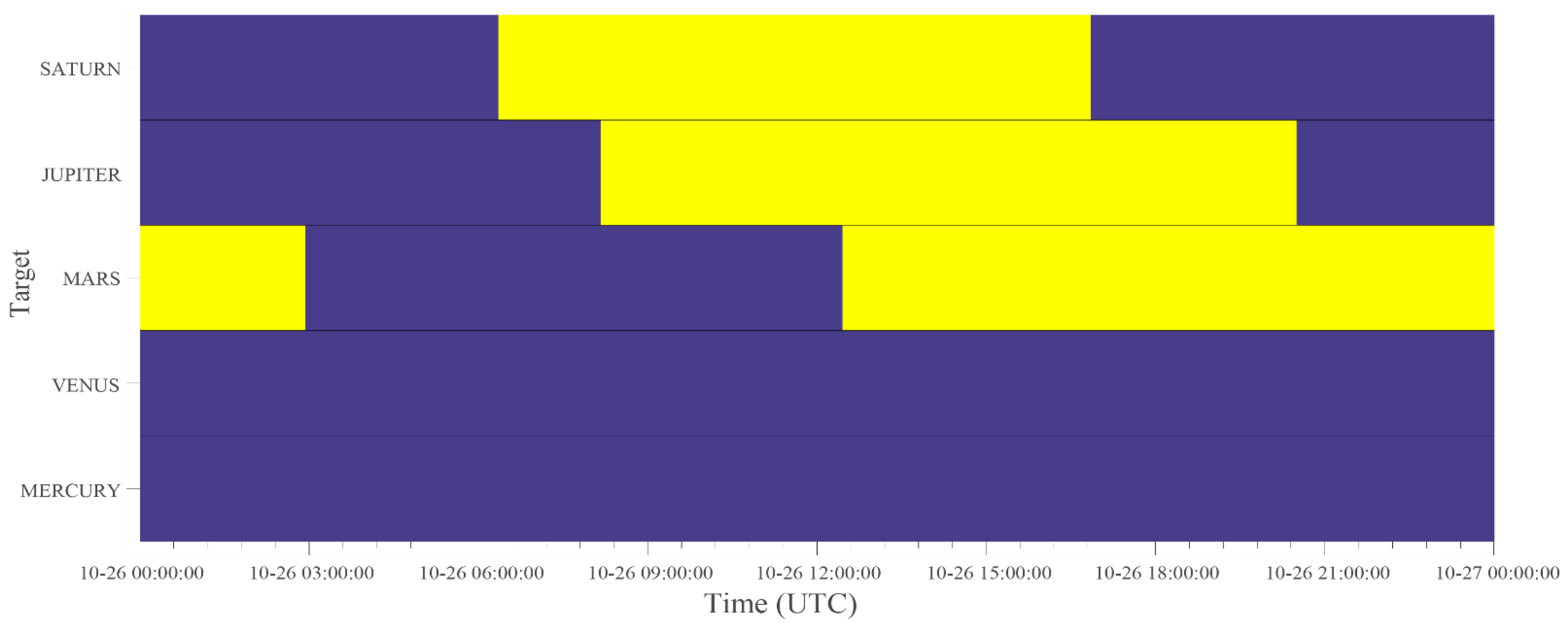
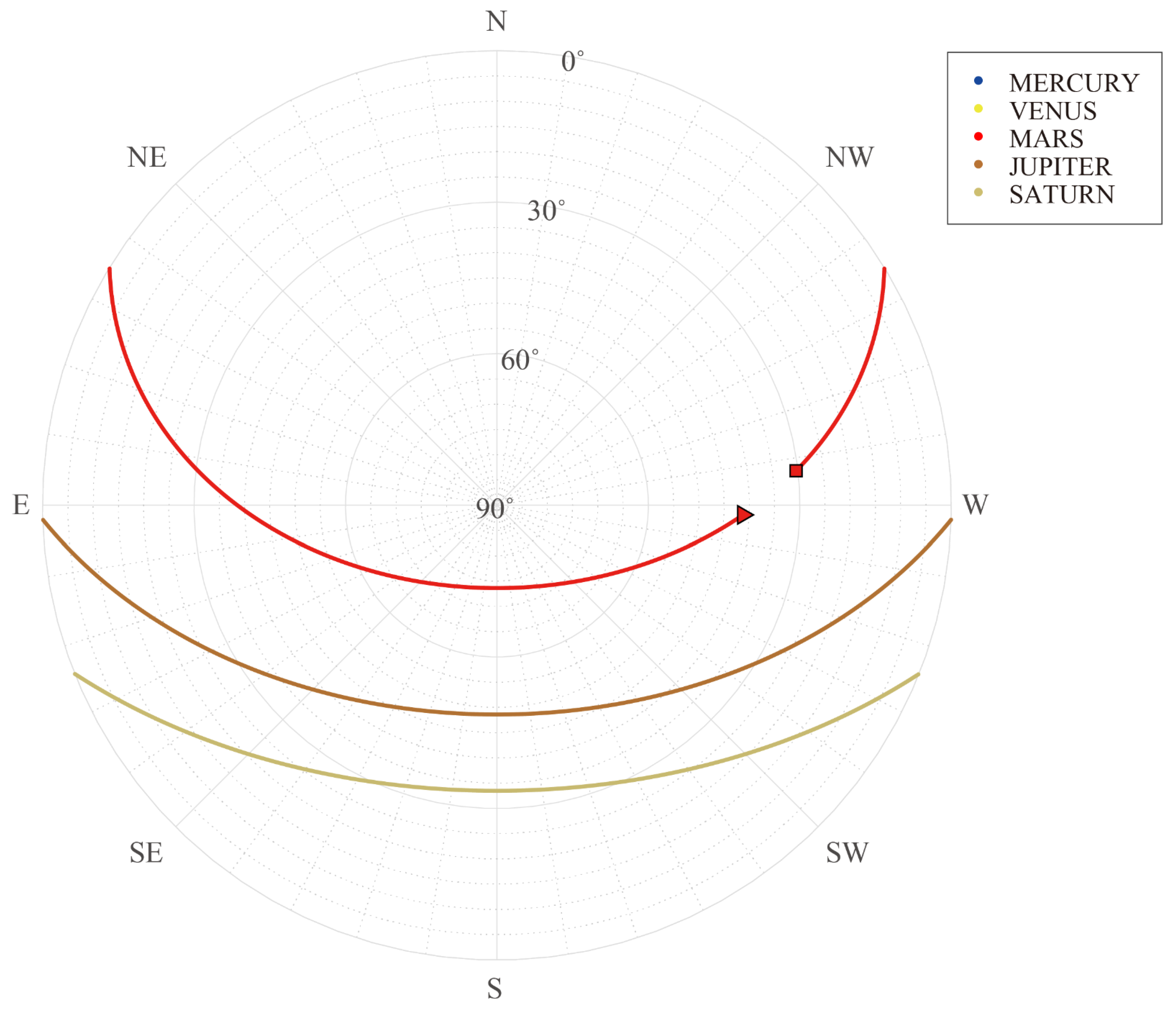
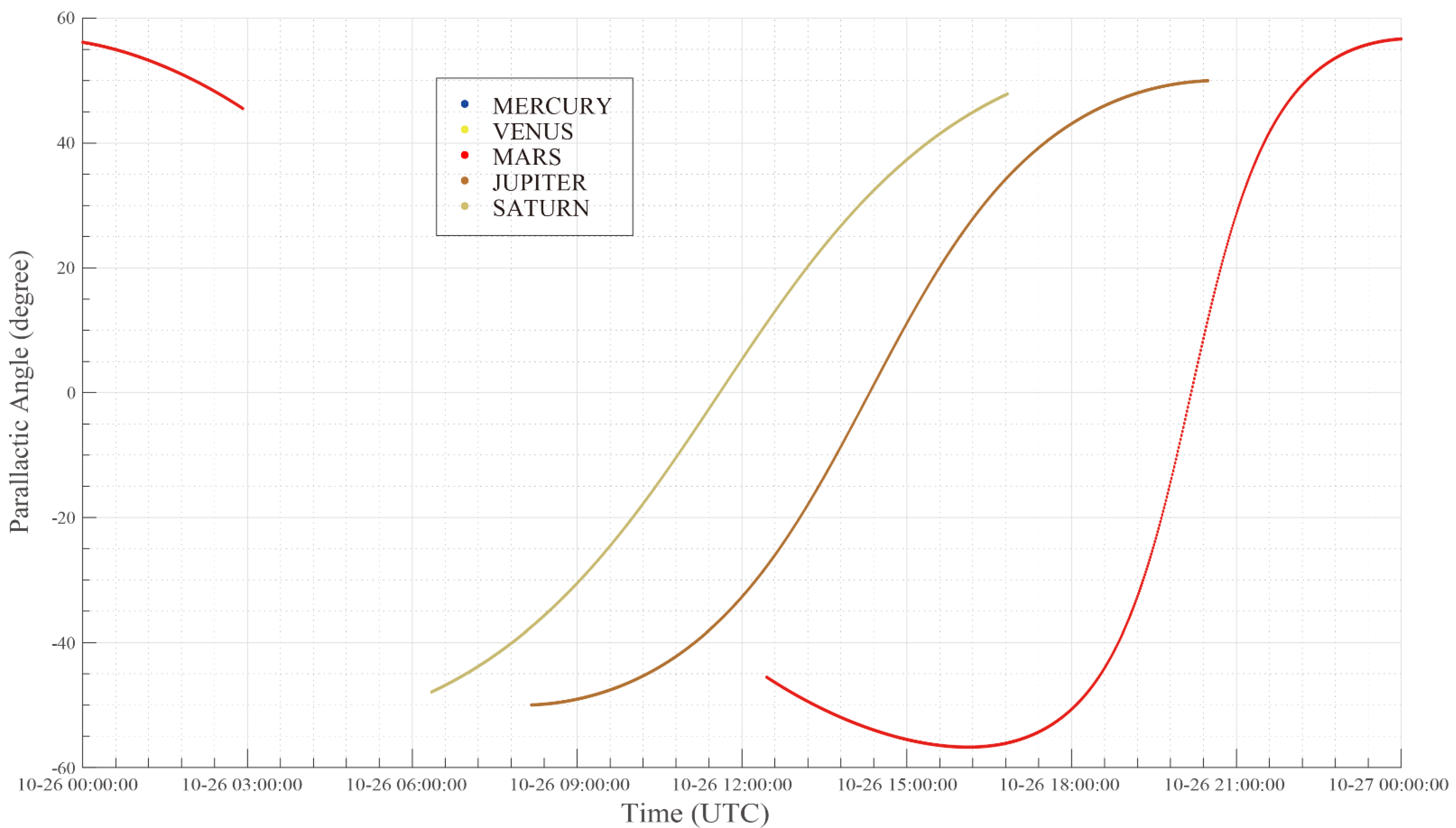
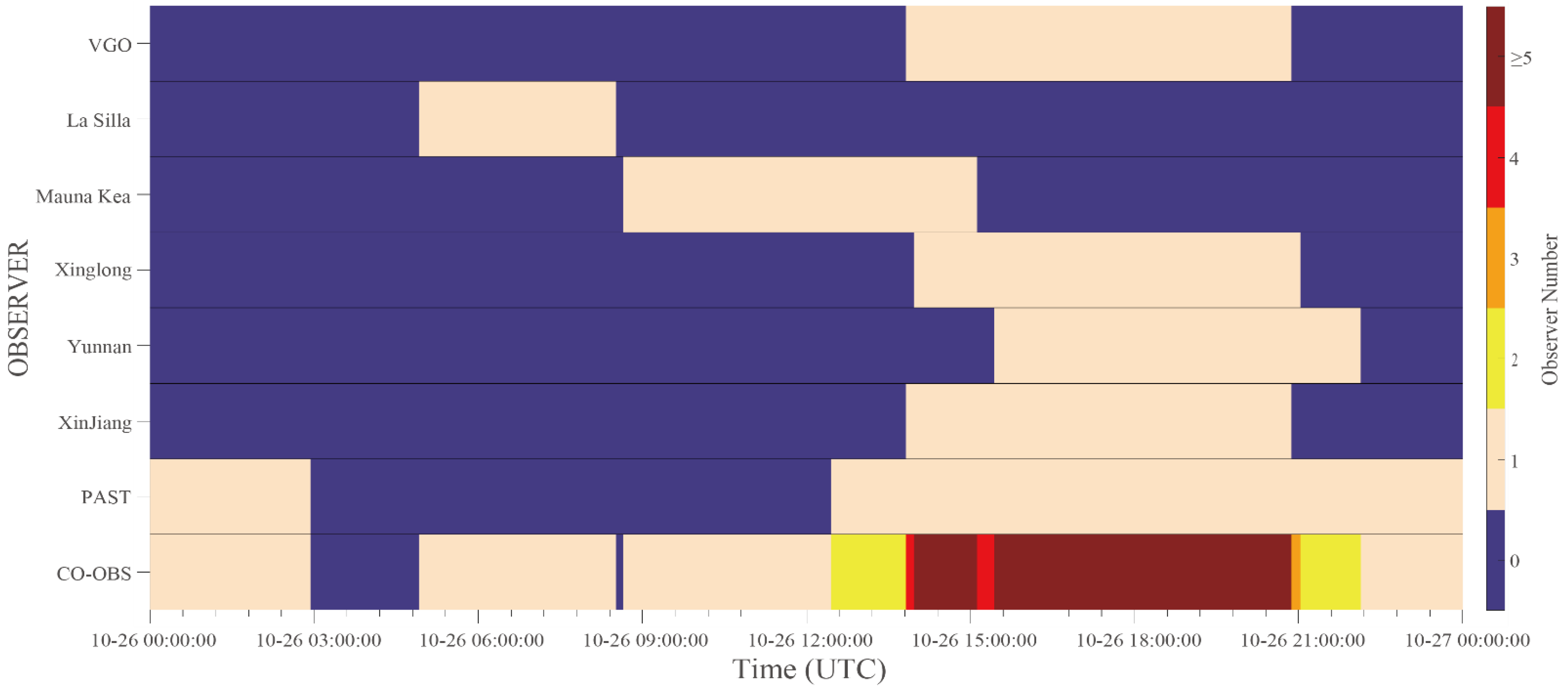
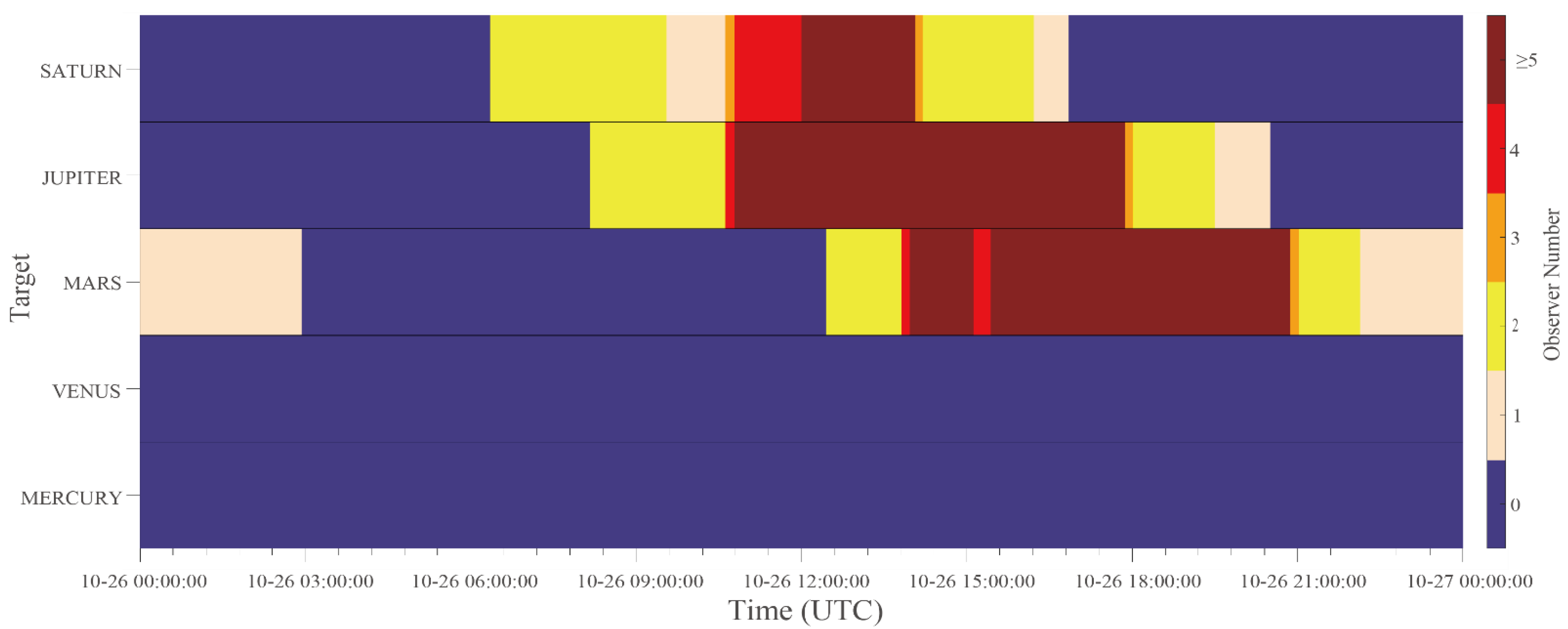
| Characteristic | Value |
|---|---|
| Flight Altitude | Above 35 km |
| Clear Aperture Diameter | 0.8 m |
| Operational Wavelength | 280–680 nm |
| Field of View | 15′ |
| Geometry Parameter 1 | Constraint |
|---|---|
| Sun Elevation Angle 2 | <−18° 4 |
| Target Elevation Angle | >20° |
| Separation Angle with the Moon 3 | >45° |
| Geometry Parameter | Constraint |
|---|---|
| Separation Angle with the Sun 1 | >15° |
| Target Elevation Angle 2 | >0° & <75° 2 |
| Separation Angle with the Moon | >45° |
| Order | Target | Start Time | End Time |
|---|---|---|---|
| 1 | Saturn | 10:37 | 10:54 |
| 2 | Jupiter | 10:55 | 15:38 |
| 3 | Mars | 15:39 | 20:51 |
| Observatory | Longitude | Latitude | Altitude |
|---|---|---|---|
| VGO | 120° E | 40° N | 4100 m |
| La Silla | 70°44′ W | 29°15′ N | 2400 m |
| Mauna Kea | 155°28′15′′ W | 19°49′25′′ N | 4207 m |
| Xinglong | 117°34′38′′ E | 40°23′45′′ N | 900 m |
| Yunnan | 100°01′54′′ E | 26°42′30′′ N | 3200 m |
| XinJiang | 81°10′30′′ E | 43°28′24′′ N | 2080 m |
| PAST | Trajectory described in main text | ||
Publisher’s Note: MDPI stays neutral with regard to jurisdictional claims in published maps and institutional affiliations. |
© 2021 by the authors. Licensee MDPI, Basel, Switzerland. This article is an open access article distributed under the terms and conditions of the Creative Commons Attribution (CC BY) license (http://creativecommons.org/licenses/by/4.0/).
Share and Cite
Shi, Z.; Zhao, Y.; He, F.; Yao, Z.; Rong, Z.; Wei, Y. Automatic Scheduling Tool for Balloon-Borne Planetary Optical Remote Sensing. Remote Sens. 2021, 13, 1291. https://doi.org/10.3390/rs13071291
Shi Z, Zhao Y, He F, Yao Z, Rong Z, Wei Y. Automatic Scheduling Tool for Balloon-Borne Planetary Optical Remote Sensing. Remote Sensing. 2021; 13(7):1291. https://doi.org/10.3390/rs13071291
Chicago/Turabian StyleShi, Zhen, Yong Zhao, Fei He, Zhonghua Yao, Zhaojin Rong, and Yong Wei. 2021. "Automatic Scheduling Tool for Balloon-Borne Planetary Optical Remote Sensing" Remote Sensing 13, no. 7: 1291. https://doi.org/10.3390/rs13071291
APA StyleShi, Z., Zhao, Y., He, F., Yao, Z., Rong, Z., & Wei, Y. (2021). Automatic Scheduling Tool for Balloon-Borne Planetary Optical Remote Sensing. Remote Sensing, 13(7), 1291. https://doi.org/10.3390/rs13071291









